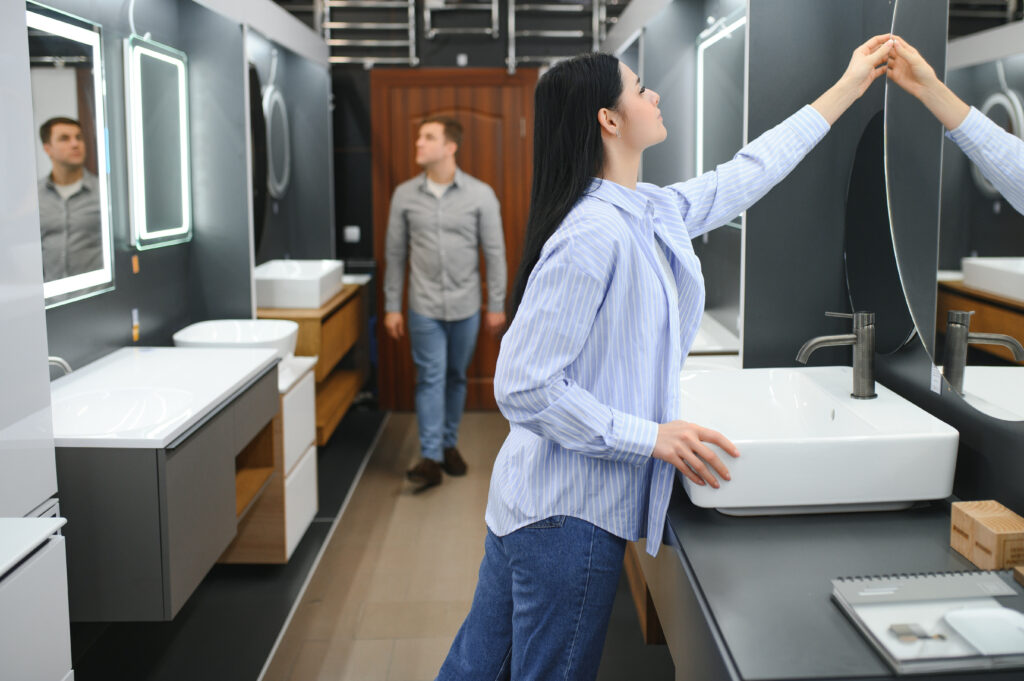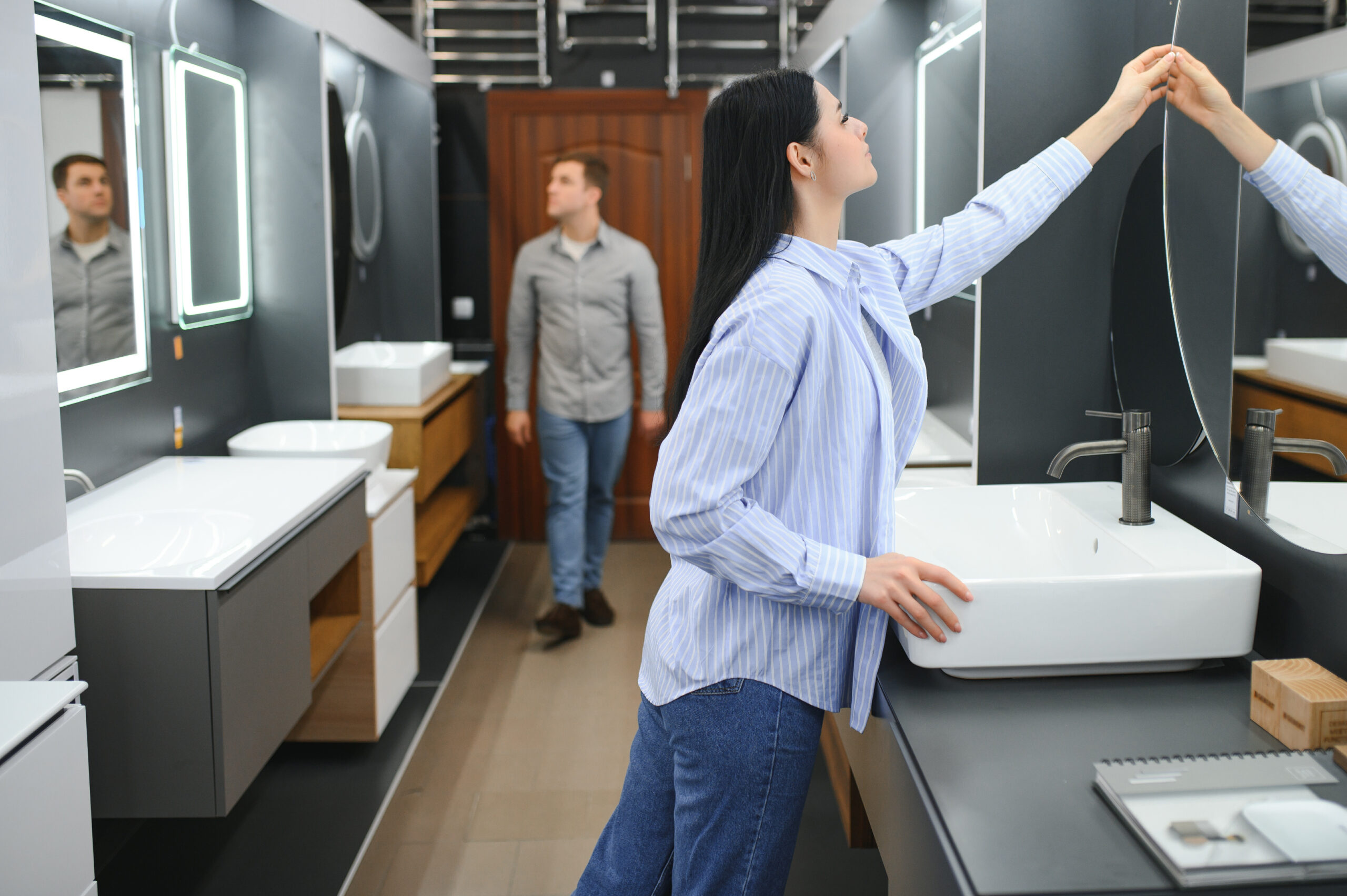I still wince when I scroll past photos of my 2014 bathroom renovation on my phone.
The geometric cement tiles I was convinced would “always be classic” now scream their exact installation date as loudly as an avocado-colored toilet would signal 1972.
That $12,000 lesson taught me something crucial: in bathroom design, there’s a profound difference between what’s enduring and what’s merely fashionable this season.
The stakes in bathroom design choices are uniquely high.
Unlike swapping out living room throw pillows or repainting a bedroom, bathroom renovations involve plumbing, tile work, and significant disruption to daily life.

Which Sink Would You Prefer?
When most renovations cost between $10,000 and $30,000 and involve weeks of construction dust and cold showers, the “lifespan” of your design choices suddenly matters enormously.
Yet timeless doesn’t mean boring. The secret lies in understanding which elements should provide lasting appeal and which can be vessels for personal expression and current trends. It’s about creating a framework that ages gracefully while allowing for evolution.
The Quiet Heroes: Investment Elements That Transcend Trends
The most enduring bathroom designs share a common trait: they’re built around elements that have already demonstrated staying power across decades or even centuries.
The Truth About “Forever” Fixtures
In twenty years of renovating homes, I’ve observed that the most dateless fixtures share specific attributes: clean lines, balanced proportions, and a certain visual quietness. While brushed brass may be enjoying its moment and matte black is currently everywhere, chrome and polished nickel have maintained consistent appeal through countless design cycles.
This isn’t just about metal finishes. Fixture forms matter equally. Wall-mounted faucets, for instance, have existed in bathrooms for over a century without ever looking outdated, while many vessel sink installations from the early 2000s now appear as distinctly time-stamped as shag carpeting.
The most revealing question to ask isn’t “What’s popular now?” but rather “What has already remained attractive for decades?” Pedestal sinks, simple undermount basins, and classic console vanities all pass this crucial test.
Material Wisdom Beyond Trends
The choice of materials in a bathroom might be the single most consequential decision affecting its longevity. Natural stone, particularly marble and limestone, has adorned bathrooms from ancient Rome to contemporary spaces without ever feeling passé.
But material selection involves more nuance than simply choosing what’s been historically present. The most enduring choices typically embody a certain restraint—white subway tile has remained relevant for over a century not because it’s exciting but because it serves as an excellent backdrop for changing styles around it.
When I renovated my forever home, I chose honed Carrara marble despite warnings about maintenance. Three years later, the slight patina and aging only enhance its character—exactly what I’d expect from a material used in Italian bathrooms for generations.
The Balancing Act: Semi-Permanent Decisions
Between the “forever elements” and easily changed accessories lies a critical middle zone where bathrooms can maintain relevance while still reflecting their era.
Vanities: Furniture That Evolves Rather Than Dates
The most adaptable bathroom vanities are those that reference classical furniture proportions rather than adhering strictly to current trends. My own mid-century home features a floating walnut vanity that works precisely because it reflects the home’s architectural era rather than my renovation date.
When selecting a vanity, consider whether its design has historical precedent or is purely contemporary. Shaker-style cabinetry has remained attractive for centuries, while many contemporary designs will likely feel dated within a decade.
The Layout Legacy
Perhaps the least discussed yet most impactful aspect of bathroom longevity is spatial planning. The impulse to maximize the bathroom features—squeezing in both a soaking tub and separate shower in a standard bathroom, for instance—often creates cramped spaces that feel uncomfortable regardless of finish selections.
The most timelessly appealing bathrooms prioritize proportion and breathing room over cramming in features. A well-designed shower often brings more daily satisfaction than a shower/tub combination included just because it seemed expected.
The Freedom Zone: Where Trends Belong
Embracing current design currents doesn’t require committing to them permanently. The key is understanding which elements can be reasonably updated.
The Low-Commitment Color Strategy
Wall paint remains the lowest-risk way to incorporate current color trends. While the teal bathrooms currently flooding social media will likely date as quickly as the pink bathrooms of the 1950s, repainting walls is a manageable weekend project rather than a demolition scenario.
For those craving more distinctive color, consider using it in lighting fixtures, textiles, or even mirror frames—elements that can be switched out without calling a contractor.
Hardware: Small Details, Major Impact
Cabinet hardware, towel bars, and even faucets can be updated with relative ease, making them excellent vessels for more fashion-forward choices. That brushed brass faucet might indeed become tomorrow’s polished brass from the 1980s, but replacing it won’t require tearing out walls.
The path to creating a bathroom with lasting appeal isn’t about ignoring contemporary design entirely—it’s about understanding where permanence matters and where flexibility can be built in. By creating a foundation of proven elements while allowing for personal expression through more easily changed components, you can create a space that feels current without being imprisoned by today’s trends.

